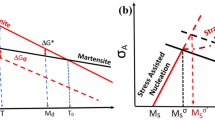Abstract
Fatigue crack growth mechanisms of long cracks through fields with low and high residual stresses were investigated for a common structural aluminum alloy, 6061-T61. Bulk processing residual stresses were introduced in the material by quenching during heat treatment. Compact tension (CT) specimens were fatigue crack growth (FCG) tested at varying stress ratios to capture the closure and K max effects. The changes in fatigue crack growth mechanisms at the microstructural scale are correlated to closure, stress ratio, and plasticity, which are all dependent on residual stress. A dual-parameter ΔK–K max approach, which includes corrections for crack closure and residual stresses, is used uniquely to connect fatigue crack growth mechanisms at the microstructural scale with changes in crack growth rates at various stress ratios for low- and high-residual-stress conditions. The methods and tools proposed in this study can be used to optimize existing materials and processes as well as to develop new materials and processes for FCG limited structural applications.

















Similar content being viewed by others
Abbreviations
- a :
-
crack length (measured from the center of specimen loading holes in the case of the compact tension (CT) specimen geometry)
- B, W :
-
compact tension (CT) specimen thickness and width
- C, m :
-
Paris regime fit parameters
- C 0 :
-
compliance in the absence of closure, above the opening load of a crack
- C i :
-
(initial) compliance prior to the initiation of a crack
- C s :
-
(secant) compliance of one compliance load-displacement record, including crack closure
- K :
-
nominal stress intensity
- K app :
-
applied stress intensity considering the effects of residual stresses
- K max :
-
nominal maximum stress intensity
- K min :
-
nominal minimum stress intensity
- K res :
-
stress intensity caused by residual stress
- ΔK :
-
nominal stress intensity range
- ΔK app :
-
applied stress intensity considering the effects of residual stresses
- ΔK cl :
-
stress intensity range under which the crack is partially to fully closed
- ΔK eff :
-
effective stress intensity range considering the effects of closure
- n :
-
degree of plane stress
- N :
-
number of cycles
- r plastic :
-
radius of the plastic zone ahead of the crack tip
- R :
-
nominal stress ratio
- R app :
-
applied stress ratio considering the effects of residual stresses
- R eff :
-
effective stress ratio considering the effects of closure
- δ :
-
displacement
- σ Y :
-
yield strength determined by 0.2 pct offset technique
References
G. Glinka: Fatigue and Fracture Mechanics, vol. 677, C.W. Smith, ed., American Society for Testing and Materials, West Conshohocken, PA, 1979, pp. 198–214.
A.P. Parker: Residual Stress Effects in Fatigue, vol. 776, H.S. Reemsnyder and J.F. Throop, eds., American Society for Testing and Materials, West Conshohocken, PA, 1982, pp. 13–31.
D.V. Nelson: Residual Stress Effects in Fatigue, vol. 776, H.S. Reemsnyder and J.F. Throop, eds., American Society for Testing and Materials, West Conshohocken, PA, 1982, pp. 172–94.
Y.C. Lam and K.S. Liam: Theor. Appl. Fract. Mech., 1989, vol. 12, pp. 59-66.
M. Beghini and L. Bertini: Eng. Fract. Mech., 1990, vol. 36, no. 3, pp. 379-87.
S.R. Daniewicz, J.A., Collins, and D.R. Houser: Int. J. Fatigue, 1994, vol. 16, pp. 123-33.
R.J. Bucci: Fatigue and Fracture Mechanics, vol. 743, R. Roberts, ed., American Society for Testing and Materials, West Conshohocken, PA, 1981, pp. 28–47.
D.L Chen, B. Weiss, and R. Stickler: Mater. Sci. Eng. A, 1996, vol. 208A, pp. 181-87.
F. Bergner, G. Zouhar, and G. Tempus: Int. J. Fatigue, 2001, vol. 23, pp. 383-94.
L.P. Borrego, J.M. Costa, and F.V. Antunes: Eng. Fail. Anal., 2010, vol. 17, pp. 11-18.
L.P. Borrego, J.M. Costa, and S. Silva: Int. J. Fatigue, 2004, vol. 26, pp. 1321-31.
D.H. Lee, J.H. Park, and S.W. Nam: Mater. Sci. Technol., 1999, vol. 15, pp. 450-55.
R. Scheffel and K. Detert: Fracture Control of Engineering Structures, H.C. Van Elst and A. Bakker, eds., EMAS Publications, Warrington, UK, 1986, pp. 1511–21.
R.H. Christensen: Appl. Mater. Res., 1963, vol. 2, no. 4, pp. 207-10.
W. Elber: Eng. Fract. Mech., 1970, vol. 2, pp. 37-45.
J.C. Newman Jr.: J. Eng. Mater. Technol., 1995, vol. 117, pp. 433-39.
S. Suresh and R.O. Ritchie: Fatigue Crack Growth Threshold Concepts, D.L. Davidson and S. Suresh, eds., TMS-AIME, Warrendale, PA, 1984, pp. 227–61.
J.K. Donald, G.H. Bray, and R.W. Bush: Fatigue and Fracture Mechanics, vol. 1332, T.L. Panontin and S.D. Sheppard, eds., American Society for Testing and Materials, West Conshohocken, PA, 1998, pp. 674–95.
P.C. Paris, H. Tada, and J.K. Donald: Int. J. Fatigue, 1999, vol. 21, pp. S47-S57.
D.A. Lados, D. Apelian, and J.K. Donald: Int. J. Fatigue, 2007, vol. 29, no. 4, pp. 687-94.
A.K. Vasudevan and K. Sadananda: Metall. Mater. Trans. A, 1995, vol. 26A, pp. 1221-34.
ASTM Standard E647, 2005, “Standard Test Method for Measurement of Fatigue Crack Growth Rates,” ASTM International, West Conshohocken, PA, 2005. DOI:10.1520/E0647-05, www.astm.org.
D.A. Lados and D. Apelian: Eng. Fract. Mech., 2006, 73, vol. 4, pp. 435–55.
Acknowledgments
The authors thank the consortium members of the Integrative Materials Design Center at Worcester Polytechnic Institute for their support and insightful contributions to this work. Special thanks are given to Dr. Paul Crepeau of General Motors and Dr. Weizhou Li of Caterpillar.
Author information
Authors and Affiliations
Corresponding author
Additional information
Manuscript Submitted November 21, 2010.
Rights and permissions
About this article
Cite this article
Lammi, C.J., Lados, D.A. Effects of Processing Residual Stresses on Fatigue Crack Growth Behavior of Structural Materials: Experimental Approaches and Microstructural Mechanisms. Metall Mater Trans A 43, 87–107 (2012). https://doi.org/10.1007/s11661-011-0879-5
Published:
Issue Date:
DOI: https://doi.org/10.1007/s11661-011-0879-5




